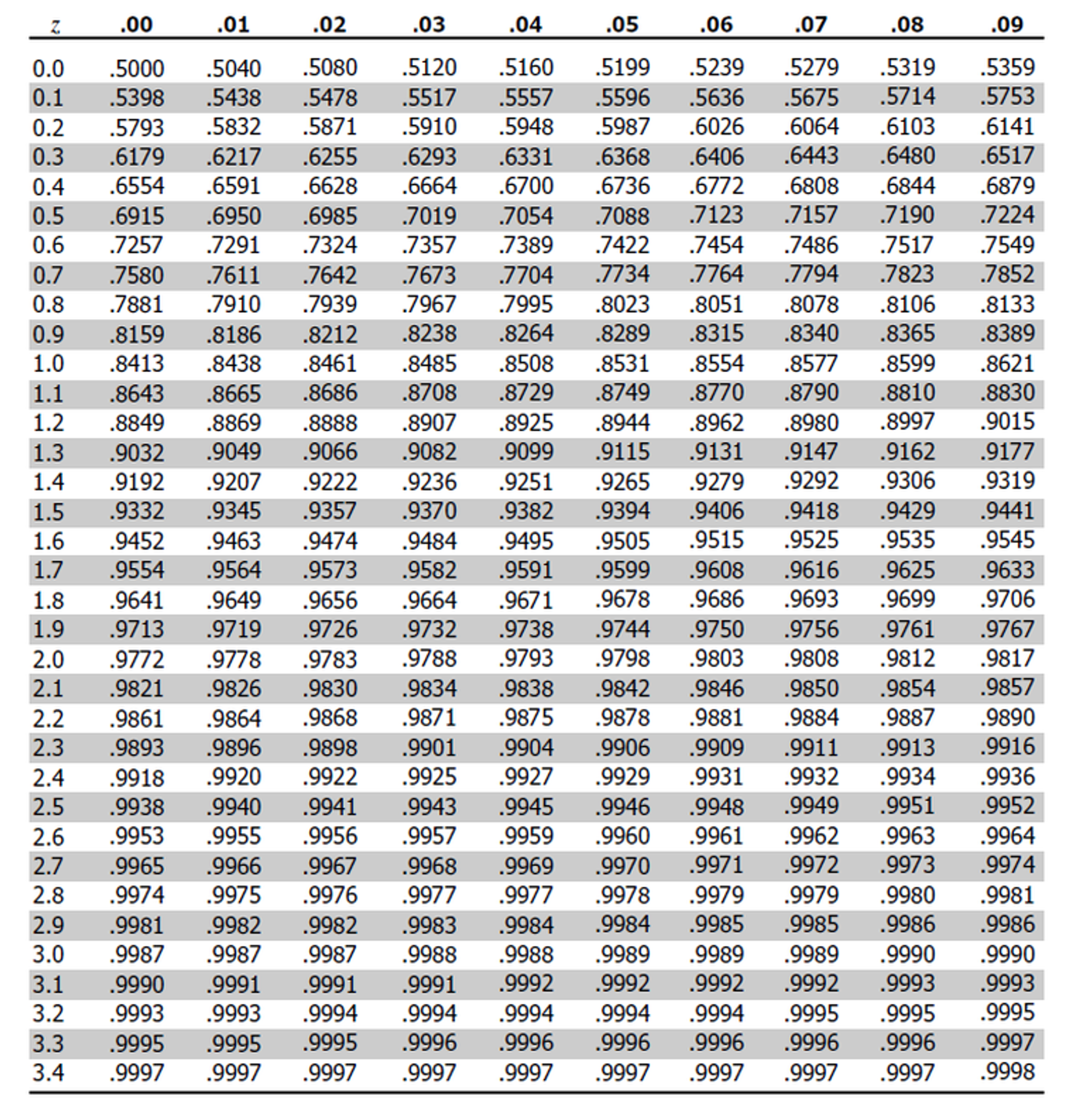Z-Scores and Probability Under the Normal Curve
Lecture 6
Farmingdale State College
Review
Proportional Breakdown
68.3%of the datapoints (the X’s) will fall within1 SDof the mean.95.4%of the datapoints (the X’s) will fall within2 SDof the mean.99.7%of the datapoints (the X’s) will fall within3 SDof the mean.
- Z-scores are expressed in Standard Deviation units.
Z-scores
Why do we care?
Z-scores re-express the original data points (the X’s) in a way that intuitively lets us know:
How close the X is to the mean
Where it falls in the dispersion of the distribution
How much this participant is like the other person in the sample
Where it falls in the dispersion of the distribution
How different this participant is from the majority of people in the sample
Z-scores
Why do we care?
Z-scores
Why do we care?
Z-scores
Imagine that \(s\) = 2 and \(\bar{x}\) = 25
\(z = 1 = 25 + 2 = 27\)
\(z = -2 = 25 - 2 = 23\)
\(z = 0.5 = 25 - .05 = 24.4\)
Calculating A Z-score
Step-by-Step
Mean-center the X values:
\(x - \bar{x}\)
- This makes the Mean = 0.
Divide by the standard deviation
\(\frac{}{s}\)
- Makes the SD = 1.
Calculating Probability
Use the normal distribution
The average grade on the exam was an 86 with a standard deviation of 4.
Calculating Probability
The average grade on the exam was an 86 with a standard deviation of 4. What is the probability of scoring a
94or higher on the exam?
Calculating Probability
Use the normal distribution
The average grade on the exam was an
86with a standard deviation of4. What is the probability of scoring a94or higher on the exam?
\(z = \frac{x-\bar{x}}{s} = \frac{94-86}{4} = \frac{8}{4}=2\)
Z =
2corresponds with2.1%and0.1%of the curve (2.2%) chance.
Example 2
Test Time!
The mean exam score was
86with a standard deviation of4. What is the probability of scoring between an82and a90?
Example 2
Test Time!
The mean exam score was
86with a standard deviation of4. What is the probability of scoring between an82and a90?
Example 2
Esmeralda’s Second Test
What is the probability of scoring between an 82 and a 90?
\(z = \frac{82-86}{4} = \frac{-4}{4} = -1\)
\(z = \frac{90-86}{4} = \frac{4}{4} = 1\)
There is a 68.3% chance of scoring between
82and90.
Example 3
Esmeralda’s Second Test
Esmeralda’s stats professor tells her class that the average score on the exam was a 72 with a standard deviation of 6, and the distribution of scores was normal. Esmeralda wants to calculate the probability that she scored below
60
Example 3
Esmeralda’s Second Test
Esmeralda’s stats professor tells her class that the average score on the exam was a 72 with a standard deviation of 6, and the distribution of scores was normal. Esmeralda wants to calculate the probability that she scored below
60
Example 3
Esmeralda’s Second Test: \(\bar{x} = 72 | s = 6\)
Esmeralda wants to calculate the probability that she scored below 60
\(\frac{60-72}{6} = \frac{-12}{6} = -2\)
2.2%chance that she failed.What’s the chance she passed?
\(100-2.2 = 97.8%\)
Z-scores and Probability
How does it apply?
In real life, we are often working with numbers with long decimal points rather than nice whole numbers.
- Because the standard normal curve is standard and normal, we can calculate the exact probability of a z-score with a decimal point.
Z-scores and Probability
The Z-Table
Locate the whole number and first decimal point along the left side of the table.
Locate the second decimal point along the top of the table.
Z-scores and Probability
The Z-Table
The Z-score Probability Table gives you the probability of that z-score or less.
- If you need that z-score or higher, you have to subtract the decimal from 1.
- Esmeralda had a
.022% chance of failing and and a1-.022%chance of passing.
- Esmeralda had a
Z-scores and Probability:
Some examples
In a recent study on world happiness, participants were asked to evaluate their current lives on a scale from
0to10, where0represents the worst possible life and10represents the best possible life. The responses were normally distributed, with a mean of5.4and a standard deviation of2.2. Find the probability that a randomly selected study participant’s response was:
Less than 4
More than 8
Z-scores and Probability:
Life Satisfaction: \(\bar{x} = 5.4 \text{ and } s = 2.2\)
Find the probability that a randomly selected study participant’s response was:
Less than 4
- \(z = \frac{x-\bar{x}}{s} = \frac{4-5.4}{2.2} = \frac{-1.4}{2.2} = -.63\)
More than 8
- \(z = \frac{x-\bar{x}}{s} = \frac{8-5.4}{2.2} = \frac{2.6}{2.2} = 1.18\)
Z-scores and Probability
Example 1: \(\bar{x} = 5.4 \text{ and } s = 2.2\)

Less than 4 (-.63)
Find .6 on the left size of the table (z column)
Find .03 column
Note where they intersect
Since we want the value less than 4, we need to subtract 1
Report the value as a percentage (\(z\times100\))
Example 1
Step by Step

More than 8 (1.18)
Find 1.1 on the left size of the table (z column)
Find .08 column
Note where they intersect
Report the value as a percentage (\(z\times100\))
Z-scores and Probability:
Example 2
The scale of scores for an IQ test are approximately normal with mean
100and standard deviation15. The organization MENSA, which calls itself the “high IQ society”, requires a score of130or higher.
What percent of adults would qualify for membership?
Find the probability of scores more than 130
\(z = \frac{x-\bar{x}}{s} = z = \frac{130-100}{15}=\frac{30}{15} = 2\)
Example 2
MENSA: \(\bar{x}=100 \text{ and } s = 15\)

More than 130 (2)
Find 2.0 on the left size of the table (z column)
Find .00 column
Note where they intersect
Remember we are thinking about 130 or more so we have to subtract 1 from our proportion.
Report the value as a percentage (\(z\times100\))







